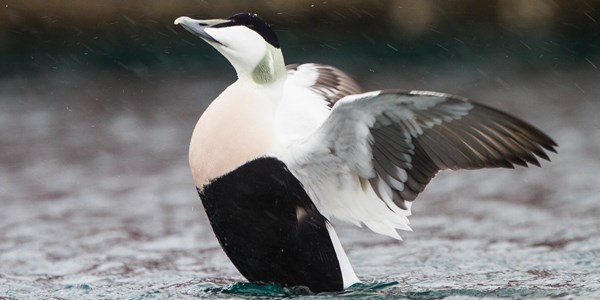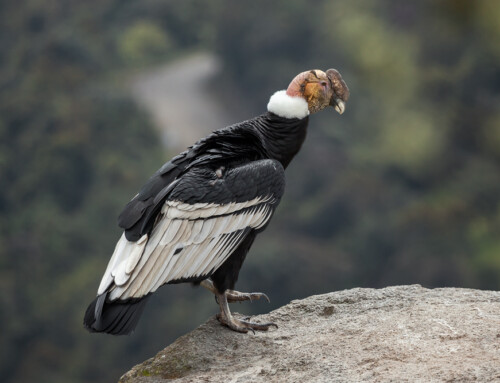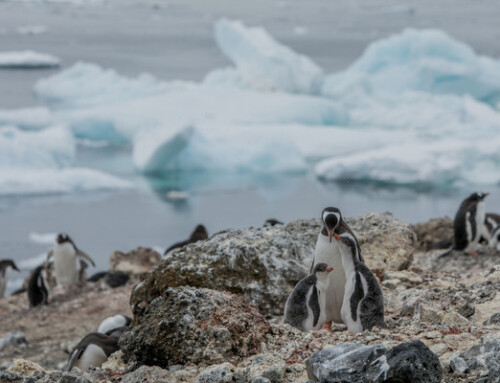LINKED PAPER
Climate‐change not only threatens bird populations but also challenges our ability to monitor them. Fox, A.D., Nielsen, R.D. & Petersen, I.K. 2019. IBIS. DOI: 10.1111/ibi.12675. VIEW
In what now seems like another age, we were concerned with protecting wetlands that provided vital refuges for western European wintering duck populations during periods of severe winter weather (Ridgill & Fox 1990). These important overspill wetlands were mostly in the Black Sea, Mediterranean and southwestern most Europe, to which these birds fled from more continental areas and even North Sea countries when temperatures plummeted below freezing and wetlands in their core wintering quarters froze solid. Because such sites only intermittently attained levels of international importance (e.g. exceeding the 1% flyway population criteria as defined under the Ramsar Convention during harsh winters), they often lacked adequate site safeguard. Yet their importance was arguably as great as those sites regularly holding internationally important numbers because they took the strain in those extreme winters when birds were most stressed by the ravages of hard weather in their traditional winter heartlands that forced them further down the flyways.
What different problems we face a mere 30 years on! Not only has the Arctic in general warmed disproportionately in the last 15-20 years, but mid-winter sea surface temperatures in the Barents and Kara Seas have shown amplified warming because of increased oceanic heat content as well as warming atmospheric conditions (Lind et al. 2018). The result has been the dramatic rapid removal of midwinter sea-ice since the mid-2000s from very extensive areas along the northern Russian Arctic coast, White and Baltic Seas, as well as reductions in ice cover in coastal and inland freshwaters throughout the region (Figure 1).
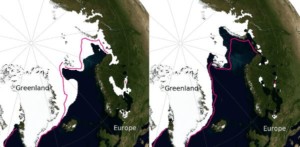
Figure 1 National Snow and Ice Data Center plots of the extent of sea-ice mapped in January 1979 (left) and January 2018 (right). The magenta line indicates the median ice edge in the years 1981–2010 inclusive. Note the relatively modest 15% reduction in total area and comparative restricted change in extent of ice cover around coastal Greenland. However, there are major consequences for open water in the Baltic and White Seas, as well as the entire Russian Arctic coast from Kanin peninsula and Kolguev Island to the entire west coast of Novaya Zemlya. Both 1979 and 2018 are not atypical for other years at the two extremes of this time series. Images reproduced from The National Snow and Ice Center at the University of Colorado, Boulder, USA: January 1979 & January 2018
Recent studies have shown corresponding substantial north and east shifts in European wintering distributions of particularly diving ducks compared with their former distributions in response to climate warming (Lehikoinen et al. 2013, Pavon-Jordan et al. 2015). The sudden availability of open water in the Russian Arctic offers novel overwintering habitat especially to sea ducks in the marine environment, but also to other species using currently unsurveyed brackish and freshwater areas far to the north and east of their former wintering range.
There is a proud tradition of waterbird monitoring in western Europe, based on coordinated international mid-winter counts going back up to 70 years in some areas. Such monitoring data provided the basis for site safeguard programmes (such as designation of Ramsar sites under the 1% criterion and Special Protection Areas under the European Union Birds Directive), which made a vital contribution to protecting these populations and maintaining their generally favourable conservation status. This has been, and continues to be, particularly important for huntable species, which as shared harvested resources, need to be maintained at levels that can be demonstrated to provide a sustainable offtake without jeopardy to their future. Monitoring of annual population size gives early warning of adverse population change, the role of macro-environment factors acting on population regulation and feedback monitoring in the case of adaptive harvest management programmes and is therefore vital to our ability to manage these populations effectively.
With such radical expansion in the mid-winter extent and distribution of open water, waterbirds have shown great plasticity in adapting to these new areas of wintering habitat, contracting out of wintering areas in the south and west of their traditional ranges to winter further to the north and east across Europe. However, we have no idea of the effects of such changes on their reproductive success and survival. Worse still, such changes in ice cover also make it increasingly difficult for us to monitor changes in overall abundance to see if distributional changes in wintering duck numbers are affecting overall population size.
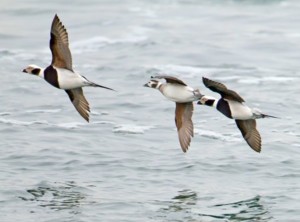
Figure 2 For species such as Long-tailed Duck Clangula hyemalis, the recent availability of extensive areas of open water free from winter sea‐ice presents real logistical challenges to effective surveying of their distribution and abundance. Photo by Mick Thompson CC BY-NC 2.0
Large proportions of European wintering waterbirds have always returned to Russia in the breeding season to reproduce, where large numbers of nesting birds dispersed over vast areas at low densities make them difficult to census outside of the mid-winter period when aggregated, making the monitoring task easier. As more birds winter in the formerly ice-free wetlands around the Baltic and in western Russia, they are effectively lost from the surveillance of western European count networks of volunteers and professionals into remote and thinly human populated areas where such cover is likely to be difficult to replicate on the scale of former mid-winter counts. Evidence suggests that numbers of some waterbird species (such as Wigeon Anas penelope, Pochard Aythya ferina and some sea duck species) returning to western Europe are genuinely declining, linked to falling reproductive success and female sex ratios, making it increasingly important to be able to differentiate between shifts in distribution and genuine declines in population size. Nowhere is this more important than for sea ducks that winter offshore, as these are the most able to benefit from access to open ice-free shallow coastal marine waters in the Russian north. More open sea areas will also permit greater shipping traffic to operate along Russian Arctic coasts, with elevated risks from oiling incidents and other potential catastrophes during the non-breeding breeding season in these waters, further underlining the need for waterbird monitoring in such areas.
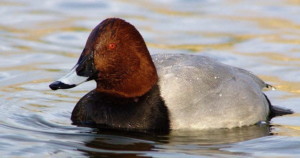
Figure 3 Evidence suggests that numbers of some waterbird species, such as Pochard Aythya ferina, returning to western Europe are genuinely declining. Photo by Leon van der Noll CC BY-NC-ND 2.0
Which such massive shifts in habitat availability and climate, the ecology and wintering distributions of ducks in the Western Palaearctic in the next 50 years will be radically different from those first described 50 years ago by Anders Holm Joensen (1974), George Atkinson-Willes (1976) and other pioneers. We owe it to their memory to maintain continuity in our current mid-winter monitoring to demonstrate the effects of declining populations and shifts in range, as well as to continue to monitor site quality and the conservation status of species within Natura2000 sites and other protected areas. However, it is clear that climate change not only threatens our waterbird populations but also increasingly challenges our ability to monitor them effectively in the future as more waterbirds overwinter in the remote northeast of Europe where we lack volunteers to monitor them. For this reason, we need to meet the challenge of major shifts in non-breeding distributions of our common waterbird populations with an informed debate about how to monitor the demography, distribution and abundance of these critical birds to best effect now, and in the immediate future, in the face of radical environmental change.
References
Atkinson-Willes, G.L. 1976. The numerical distribution of ducks, swans and Coots as a guide to assessing the importance of wetlands in mid-winter. In Smart, M. (ed.) Proceedings of the International Conference on the Conservation of Wetlands and Waterfowl. Heilingenhafen, Federal Republic of Germany, 2–6 December 1974: 199–254. Slimbridge: International Waterbird Research Bureau.
Joensen, A.H. 1974. Waterfowl populations in Denmark 1965–73. Danish Review of Game Biology 9: 1–206.
Lehikoinen, A., Jaatinen, K., Vähätalo, A., Clausen, P., Crowe, C., Deceuninck, B., Hearn, R., Holt, C.A., Hornman, M., Keller, V., Nilsson, L., Langendoen, T., Tománková, I., Wahl, J. & Fox, A.D. 2013. Rapid climate driven shifts in winter distributions of three common waterbird species. Global Change Biology 19: 2071-2081. VIEW
Lind, S., Ingvaldsen, R.B. & Furevik, T. 2018. Arctic warming hotspot in the northern Barents Sea linked to declining sea-ice import. Nature Climate Change 8: 634–639. VIEW
Ridgill, S.C. & Fox, A.D. 1990. Cold Weather Movements of Waterfowl in Western Europe. IWRB Special Publication no.13. IWRB, Slimbridge.
Image credits
Featured image: Common Eider Somateria mollissima | Ron Knight | CC BY 2.0


